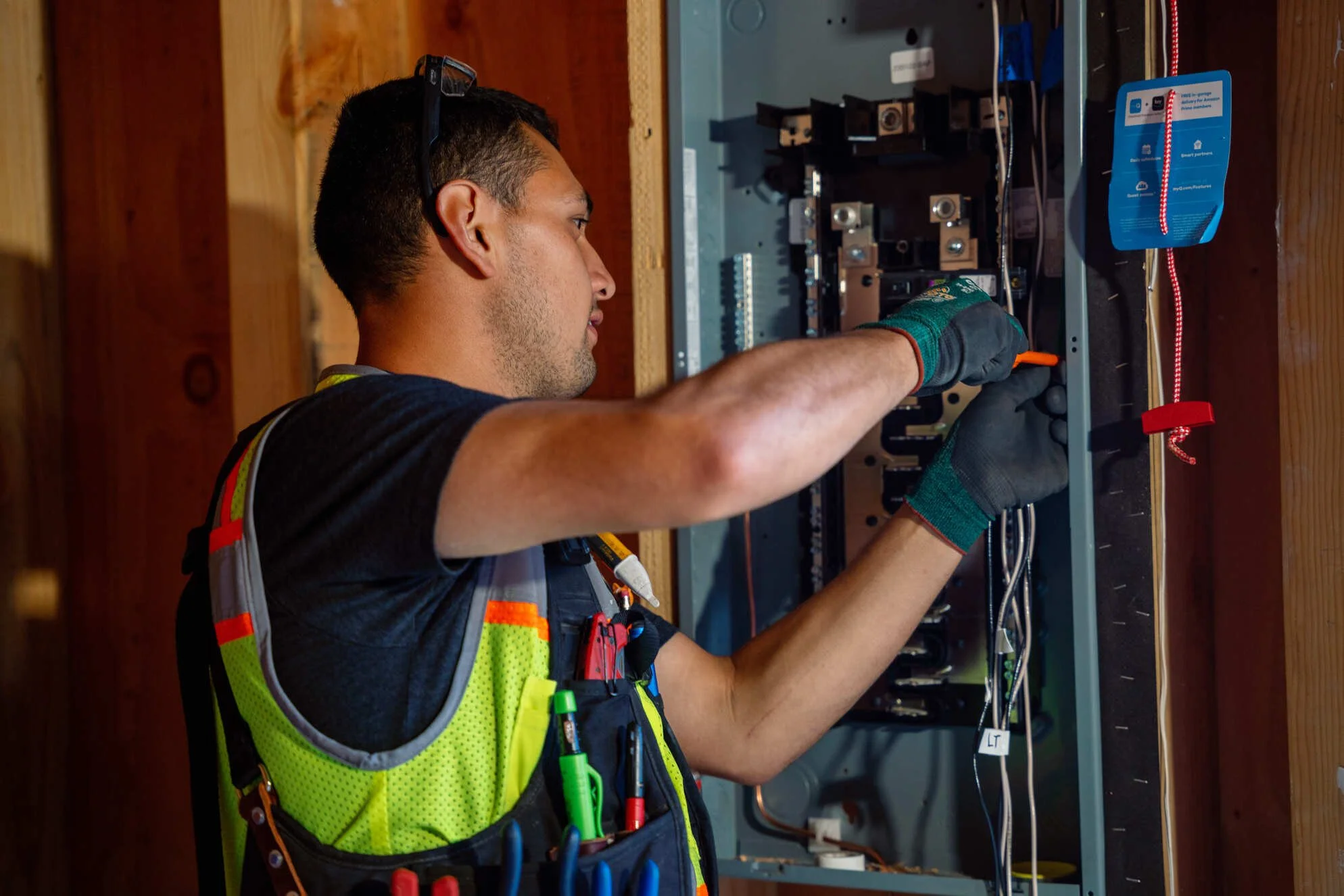Old Wires Out Bright Days In
Electrical systems don't age gracefully.
Wiring That Predates the Microwave Deserves Retirement
Electrical systems don't age gracefully. Wires installed before the advent of smart TVs, induction cooktops, and electric vehicle chargers weren't designed for homes filled with these devices. They weren't even dreaming about the day someone might try to simultaneously power a robot vacuum and a smoothie blender.
Whole-home rewiring is more than just a glow-up for what's behind the drywall. It's about safety, reliability, and giving every switch, outlet, and appliance the power to shine—without flickers, blown fuses, or that faint smell of something warm that shouldn't be.
The Warning Signs Start Small
Flickering lights, warm outlets, buzzing switches, and tripped breakers don't always scream "rewire me now," but they're definitely whispering it. These signals often originate from aging insulation, overloaded circuits, or connectors that haven't gripped a wire properly since rotary phones were in vogue.
Electricians trace those clues to the source, evaluate the system's condition, and recommend whole-home rewiring when piecemeal repairs no longer cut it. It's not about overkill—it's about heading off bigger problems while the lights still work.
Aluminum Wiring Never Plays Nice for Long
Homes built during the 1960s and 1970s may still be equipped with aluminum wiring, which appeared to be a budget-friendly substitute for copper at the time. Fast-forward a few decades, and aluminum's tendency to expand, contract, and oxidize has made it a regular guest on the electrical hazard list.
Whole-home rewiring removes aluminum completely, replacing it with modern copper wiring that's stronger, safer, and far less prone to overheating or working loose. It's one of those upgrades where nobody misses the original once the lights stop pulsing every time the toaster kicks on.
Overloaded Panels Say It All
Old electrical panels often reflect the lifestyle of a bygone era—one where two appliances running at once was considered ambitious. Add a couple of chargers, a space heater, and a weekend baking project, and suddenly the panel's throwing in the towel.
Professionals assess panel capacity during a whole-home rewiring job, upgrading it to meet the modern needs of the household. That often includes a service upgrade from 100 to 200 amps, room for dedicated circuits, and breakers that don't feel overwhelmed by a morning espresso routine.
More Outlets, Fewer Power Strips
A telltale sign of outdated wiring? Power strips are hiding behind every couch and side table like they're part of the décor. Older homes typically feature too few outlets, placed in inconvenient locations, and wired to circuits that weren't designed for multitasking.
Rewiring the home includes redesigning outlet placement for functionality. Electricians install grounded, tamper-resistant outlets throughout each room, providing safe access while avoiding trip hazards and minimizing the need for stretched cords in high-traffic zones. That includes thoughtful additions like USB ports or switched outlets for lamps and holiday lights.
Safety Comes Standard, Not as an Upgrade
Electrical codes evolve for a reason. Newer rules require the installation of ground fault circuit interrupters (GFCIs) in kitchens, bathrooms, garages, and other damp locations. Arc fault protection (AFCIs) is now standard in many living areas. Older homes didn't come wired for those features, but they should be.
During a whole-home rewiring project, electricians update the system to meet current code, installing GFCI and AFCI protection where required. That means fewer worries when plugging in a hair dryer or vacuum cleaner and more peace of mind for families with kids, pets, and curious guests.
Lighting That Actually Lights Things Up
Old circuits can dim lighting performance, especially when voltage drops under load. Rewiring restores power consistency, allowing new LED fixtures, dimmers, and smart switches to work as intended.
Electricians plan lighting circuits that balance load, minimize flicker, and support customization. Whether it's under-cabinet strips, recessed cans, or bold pendant lights over the kitchen island, the new wiring allows the fixtures to shine their brightest—without humming, buzzing, or cutting out mid-dinner.
Dedicated Circuits Mean No More Circuit Roulette
Shared circuits were once the norm. One breaker might power half the house, leaving appliances, outlets, and lights battling for electricity. That's how vacuuming in one room turns off the TV in another—and no one's amused.
Whole-home rewiring eliminates those surprise outages by providing dedicated circuits where needed. High-draw appliances, such as dishwashers, microwaves, washers, and dryers, have their own dedicated lines, reducing interference and preventing breaker trips that often occur at the worst possible time.
Ceiling Fans, Heavy Fixtures, and the Right Support
Many older homes have ceiling boxes never intended to hold the weight of today's decorative fans or oversized light fixtures. Even if the wires can carry the load, the boxes may not be able to withstand the strain, especially after years of vibration.
During rewiring, electricians replace ceiling boxes with fan-rated hardware and verify that all fixture supports are in place. They also make sure each junction is properly grounded and wired for the fixture's wattage and controls. No more guessing whether the fan will wobble itself loose or take a nosedive during movie night.
Low-Voltage Infrastructure for Modern Living
Homes built before Wi-Fi and streaming didn't have low-voltage wiring in mind. Audio systems, Ethernet connections, security cameras, and smart home controls all need dedicated pathways that play well with the rest of the electrical system.
Whole-home rewiring includes running coaxial, CAT6, speaker wire, or fiber where needed. Electricians route low-voltage lines with proper separation, shielding, and access points, creating a clean, dependable network that avoids the need for punching holes in drywall or stringing cables through air vents.
Hidden Junction Boxes Are More Suspicious Than Helpful
In some older homes, junction boxes are often hidden behind walls or ceilings—out of sight and often out of compliance. That makes troubleshooting nearly impossible and creates serious fire hazards when connections overheat without warning.
During a full rewire, electricians locate, remove, or properly relocate every junction. All splices are housed in accessible, secure boxes with clearly labeled components. It's not glamorous, but it's the difference between a home that's safe and one that's just quietly taking risks.
Future Upgrades Made Simple
Whole-home rewiring lays a clean, organized foundation for future upgrades. Whether adding a hot tub, installing solar panels, or finally creating that home office, the electrical system supports it without backtracking or last-minute rewiring.
Professionals build with expansion in mind, leaving conduit paths, panel space, and labeled circuits for whatever ideas come next. It's like planting wires with the future in mind—except no digging required later.
Inspections Pass Because the Work Speaks for Itself
Rewiring a home includes pulling permits and scheduling inspections. That's not red tape—it's the part where a professional gets to show off. Clean wire runs, secure connections, labeled circuits, and up-to-code installations all lead to smooth approvals.
Electricians who specialize in whole-home rewiring welcome that level of scrutiny. They build systems that pass the first time and perform for decades. They don't patch or hide—they build correctly and confidently.
Peace of Mind Is Built Into Every Wire
It's easy to overlook what's behind the walls when everything appears to be working. But when things start flickering, buzzing, or tripping, the wiring becomes impossible to ignore. A full rewire replaces questions with clarity.
Every light, outlet, fan, and appliance operates with quiet confidence. No buzzing, no flickering, no "what was that?" when the furnace turns on. Just steady performance, safer living, and the confidence that comes with knowing the entire electrical system is working as hard—and as quietly—as the people living in the home.
Bright Days Ahead Start With Better Wiring
The difference between a house that works and one that's working against its own wiring isn't always visible. But it's always felt. Whole-home rewiring replaces stress with structure, outdated parts with modern ones, and guesswork with certainty.
Every flicker eliminated, every outlet properly grounded, every circuit thoughtfully mapped—it all leads to a better home experience. Not louder, not flashier—just brighter, safer, and quietly built to last.

